A few weeks ago I discovered that in 2014 the USGS published GeoPDF's of their entire Historical Topo Map Collection and that the folks at ESRI had put together a really friendly interface for downloading them.
I became intrigued at the idea of integrating that data into my trails site and after some fruitless searching for a tile server, eventually just downloaded the GeoPDF's for most of North Georgia, cobbled together some scripts to crunch them, and built my own tiles.
Voilá!
My trails site now has Historical Topo layers, with maps that were current as of 1888, 1892, 1914, 1936, 1946, and 1972. Surveying practices 1936 were rather less advanced, so the terrain doesn't line up so well with more modern maps, but if you open 2 windows, with the old map on the left and the new map on the right, you can A-B them and match things up reasonably well.
As soon as I had that working, I scoured the maps, hoping to answer some of the questions that I had developed over the years... Ha! Yes! Hightower Gap was once called Etowah Gap. Yes! The Chestatee WMA around Dicks Creek and Blood Mountain Creek was once heavily populated. Yes! Various trails predated logging. They were just the way people went to get over the mountains to access other communities.
I also made several new discoveries. The community surrounding present-day Lake Winfield Scott was once named Quebec. Nimblewill was once named Randa. The ruins near Winding Stair Gap were once a ranger station. But, most interestingly, to me at least, was that from at least as far back as 1888 until some time between 1914 and 1936, the main drag from the church near Bull Mountain (Nimblewill Church) to the church at the bottom of Noontootla (Fellowship Primitive Church) followed a most interesting and unexpected route.
I felt like I'd explored the Blue Ridge WMA more thoroughly than any other section of the Chattahoochee National Forest, but a glance at those maps made me realize just how little I'd truly discovered.
The section of the old road from Nimblewill Church to Winding Stair Gap originally ran up along a ridge behind the church until it teed into to the present-day Bull Mountain trail, then followed that up to Bull Mountain proper, followed the Whoop-de-do's down to Booger Holler, hung a left, crossed Lance Creek, hung a right, then led up some unnamed ridge to the present-day PR Gap Trail to PR Gap proper, then hung a left and followed present-day FS77 up the ridge up to Winding Stair Gap.
I had long wondered about the origin of some of those roads and trails. Conventional wisdom would declare them old logging roads, and they may well have been used for that at some point, but, in fact, they predated all logging activity. Way back, they were just the roads that connected communities.
I had never seen two sections of that route before. The one leading up to Bull Mountain, and the one leading up the ridge behind Booger Holler. After much debate over which to check out, I eventually settled on the one behind Booger Holler, and set out to explore it this past Saturday.
On the way in, I passed a group ride, just finishing up. 20+ mountain bikers climbing back up to the church on 28-1. For a minute, I wished I was among them. I need to work on my brakes though, or more precisely, I need to get Glen to work on them, and I was way too busy, and way too broke for any of that last week. I spewed encouraging words out the window as I passed each rider though, and I got a few smiles in return, but only a few. It looked like it had been a long ride.
Pulling around in behind Booger Holler, I parked on FS77A, in a spot next to a heavily graffiti'ed beech tree.
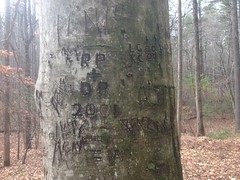
Ahh, juvenality at its finest. The word "penis" appears, by itself, no fewer than 3 times.
Heh. I also noticed the initials of my brother John and his wife, though I don't think they were the ones who carved them.
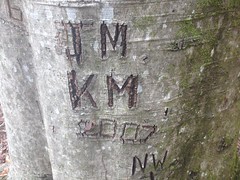
I located the trail right away. It certainly helps to know where it ought to be. It also helped that it was winter. I had attempted to locate and explore all of the various trails back there 10+ years ago, in the spring, and found a dozen or so, but never even noticed this one.
This was the general character of the trail, for quite a while.
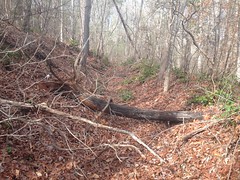
Deep below grade. A bowl, the primary purpose of which, these days, is to collect deadfall and brush. It was slog to walk in, and it was substantially easier to walk through the woods to one side of the trail, rather than down it. It didn't appear that anyone else had done this recently though, or did it with any regularity.
Well, I say that. At a point, a distinct side-trail appeared...
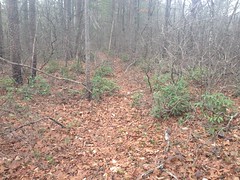
...and it was very easy to follow. It seemed like a horse trail. Hard to say why. It was very hard-packed. The canopy around it was high. But, most notably, little sticks and branches were intact. People tend to step on them, and break them, or kick them out of the way. Cyclists run them over and break them. I guess horses tend to step over them. I guess that's why it intuitively seemed like a horse trail. I didn't see any proof though. No prints. No "sign". The trail reminded me of a similar trail that leads up along a similar old road from the Kellum Valley area, over Carr Gap. I know that trail was created by riders on horseback, as evidenced by prints. This trail had the same feel.
The trail eventually teed in to what I had always called the PR Gap trail.
At the intersection, I was surprised to see this old road sign, nailed to a tree nearby.
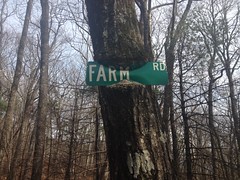
The tree is eating the sign, but marvelously managed to work itself in between the metal and the paint.
Wow!
I've seen trees absorbing signs before, but never with such precision.
"I consume the metal and reject the paint."
I'd actually seen that sign before, long ago, the one time I climbed the trail, but I'd forgotten all about it, and apparently that was back before I started taking photos of everything.
The kick up to PR Gap proper was as steep as I remembered, but surprisingly devoid of leaves. There was a time when I referred to the PR Gap Trail as "The Deep Leaves Trail" and anyone who'd hiked or ridden it knew exactly what I meant.
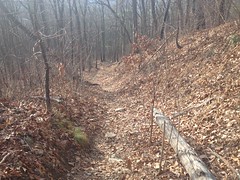
Being winter, I could see way off into the Piedmont, but photos never seem to capture the experience. I guess your mind filters out the trees in the foreground.
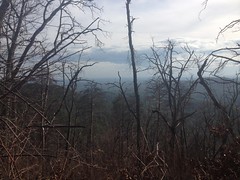
Ahh, PR Gap proper.

Why PR Gap? P stands for a creative term for urination, and R stands for "rock". Apparently, at some point, there was a large rock exposed at the gap, and it appeared to have been urinated on by a great many animals. It was scaly, and stunk and there were often puddles on it. So goes the legend, at least. I can't remember whether it was Steve Houghton that told me that, or Larry Thomas. Maybe one told me and the other confirmed it, or something. Anyway, that's what it stands for.
In retrospect, I'm not sure why I climbed up to the Gap. I had no intention of continuing up the ridge. It was fortuitous though. I noticed that there's an overgrown turn there at the intersection. You can clearly see that the PR Gap Trail used to hang a left and continue up along the route of modern FS77. It's difficult to see in the summer, but it was super clear at that time.
Ok, so I confirmed that chunk of the Old Winding Stair Gap Road existed. My primary mission was accomplished. My map had several dotted green lines on it though, representing unexplored side-trails in the area. I figured I'd head back down and check those out.
On the way down, I noticed lots of little bits of evidence, indicating who used the trail. A diverse crowd, it seemed. There were hoof prints, a bike tire track, boot prints, rock piles leading up to logs, ammo...

...glow sticks...
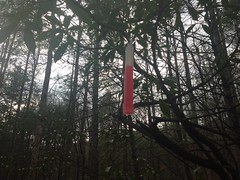
...a glove. I even found a pair of what looked like shooting glasses on the ground and hung them on a limb nearby.
Yes, a diverse crowd indeed.
The trail is rather scenic. It feels like a miniature version of Mountaintown, with fewer creek crossings. There's also this really big rock that you can go either way around.

Just past the rock I found a teeny tiny little nest on the ground. It couldn't have been 3 inches across.
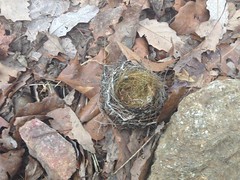
For a hummingbird?
I followed a side trail waaaay up along the creek there. I call it a side trail. Actually, I think it may have been the original route. The current route hangs a hard right (if you're climbing) and gets narrow and steep at that point, and the "side-trail" keeps going straight and remains wide and shallow, like the trail below.
It led way up along the creek before finally terminating, distinctly. There were several little spots along the trail that had obviously been leveled artificially, and various spurs that jutted off of the main trail and terminated at the creek. The whole thing was enigmatic though. What was its purpose? Logging, of course, comes to mind, but it didn't feel like a logging network, and if it was logged, it was a very long time ago. The forest looked really mature. There were no stumps. The road was wide like a modern FS road, not narrow like the roads of the Gannett era. My best guess was an "all of the above" kind of guess. Someone lived back there. They let someone log the upper reaches of it, then sold it to the FS, who widened the road and created some campsites, but then eventually abandoned it. The campsite theory also fits with the various 55 gallon drums that litter the lower reaches of the trail. I don't understand the little juts over to the creek though? They're not ideal for camping by any stretch. I'd seen that kind of thing before though, along what I knew to be a logging spur. In comparison with the Upper Chattahoochee though, it really doesn't look like it was ever logged, or cleared for farming, for that matter.
No idea.
Somewhere back in there I found this poor little mouse lying on the ground, getting eaten by ants.
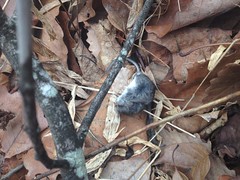
Poor little guy.
And there was also this trash bag, labelled, as far as I could tell, "Niblet Auction".
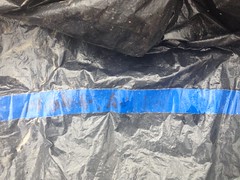
It probably doesn't say that, but I've been wracking my brain to guess what it does say. I remember once finding an old Chrysler New Yorker in the woods, and the "New Yorker" logo had little bits broken off of it, and a bit of flashing on the r's too, making it look like "Lew Nonken". I never figured it out. My mom determined the make of the car by comparing photos of the fenders and grill. Only then did I realize what the logo said. No such clues with this one.
Somewhere around that point, my phone died, suddenly, with 20% battery life left. Hmm... Might be time for a new phone.
So, no more photos. But, it wasn't that big of a deal. I didn't do much else other than hike down and back to the car. I did check out a few side trails, but they didn't go anywhere. They honestly looked like logging skids. The ridge above them looked rough, but the lower slopes looked like they'd never been touched. I wonder if that's something that was done at some point - cut a road up along a creek, then harvest the ridge to either side, but leave a buffer between the clear cut and the creek.
Actually, that may have been done unrelated to logging. If I owned land in an area with a creek and an an adjacent ridge, with no significant flats, I might build my house down by the creek, but cut a road up to the ridge, clear it, and plant or graze up there. It would be the most level land and get the most consistent sunlight. I guess that would explain the various ridge-line food plots that still dot the forest. Some of them, at least.
Eh.. Whatever. I puzzled about it on the way back to the car and puzzle about it still. I wonder if there are even more detailed historical maps of some of the areas I've explored.
It was officially dark on the way out of the woods. I grabbed some red curry at the Thai Cuisine in Dawsonville. I'd seen it for years, but never stopped in. I enjoyed it, but it was a bit onion-heavy.
I'll have to remember that for next time.



I stumbled upon this site and found this post fascinating. Just felt like saying that.
ReplyDeleteMe too! We own a little cabin right behind bull mountain, close to the jones creek dam, and I love trying to figure out all the history of the surrounding area. Maybe one day we can take a hike together! My name is Lauren White and my contact info is. 310-488/6825 and Lafactor@me.com
ReplyDeleteP.S. I’ve been exploring as many trails as I possibly can back there, taking notes and pictures along the way, researching etc. I recently joined a Facebook group for Native American “marker trees” and may have convinced the admin to share the location of a few marker trees off of winding stair gap rd. We’ll see lol
ReplyDelete